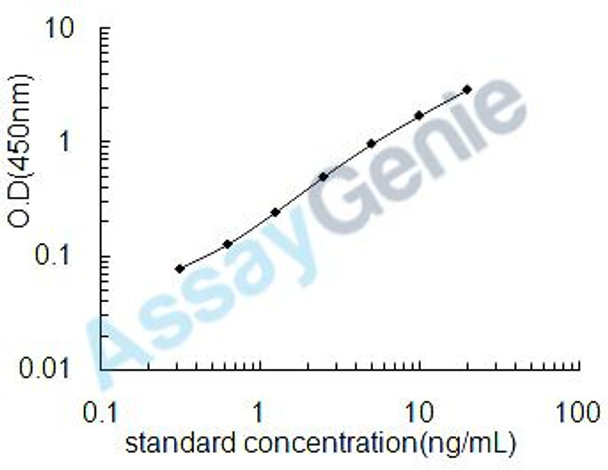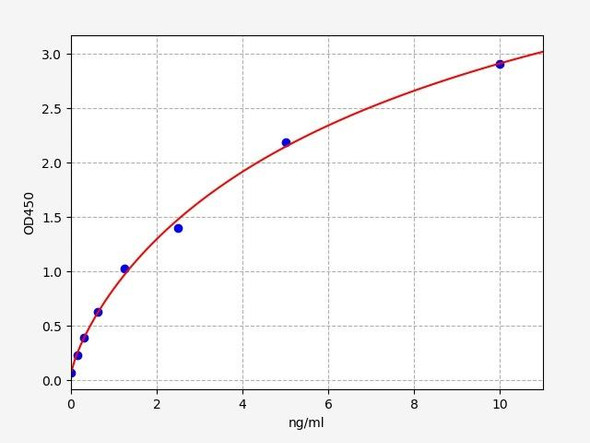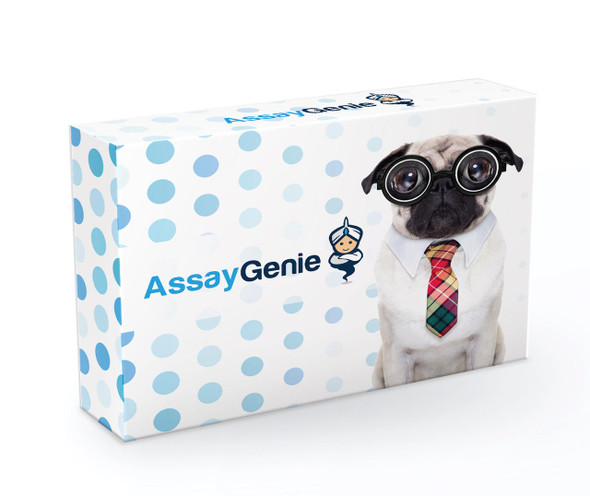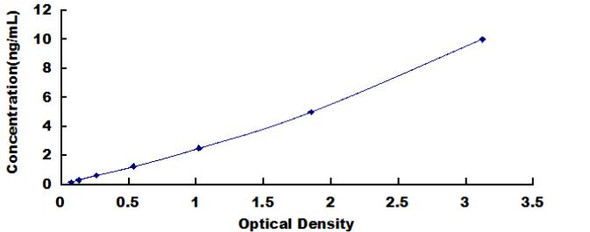Description
Rat Glucocorticoid receptor (Nr3c1) ELISA Kit
The Rat Glucocorticoid Receptor (NR3C1) ELISA Kit is a highly reliable and sensitive assay designed for the accurate quantification of rat glucocorticoid receptor levels in various sample types, including serum, plasma, and cell culture supernatants. This easy-to-use kit provides precise and reproducible results, making it an excellent choice for a wide range of research applications.The rat glucocorticoid receptor, also known as NR3C1, plays a critical role in regulating stress response, metabolism, inflammation, and immune function. Dysregulation of this receptor has been implicated in various diseases, such as autoimmune disorders, metabolic disorders, and mood disorders.
Therefore, measuring its levels can provide valuable insights into these conditions and aid in the development of potential therapeutic strategies.Overall, the Rat Glucocorticoid Receptor (NR3C1) ELISA Kit is a powerful tool for researchers looking to study the function and regulation of the rat glucocorticoid receptor in health and disease. Its high specificity and accuracy make it an essential component of any laboratory investigating related research areas.
| Product Name: | Rat Glucocorticoid receptor (Nr3c1) ELISA Kit |
| SKU: | RTEB1122 |
| Size: | 96T |
| Target: | Rat Glucocorticoid receptor (Nr3c1) |
| Synonyms: | Nuclear receptor subfamily 3 group C member 1, GR, Grl |
| Assay Type: | Sandwich |
| Detection Method: | ELISA |
| Reactivity: | Rat |
| Detection Range: | 0.156-10ng/mL |
| Sensitivity: | 0.059ng/mL |
| Intra CV: | 5.1% | ||||||||||||||||||||
| Inter CV: | 9.9% | ||||||||||||||||||||
| Linearity: |
| ||||||||||||||||||||
| Recovery: |
| ||||||||||||||||||||
| Function: | Isoform A: Has transcriptional activation and repression activity. Mediates glucocorticoid-induced apoptosis. Promotes accurate chromosome segregation during mitosis. May act as a tumor suppressor. May play a negative role in adipogenesis through the regulation of lipolytic and antilipogenic gene expression. |
| Uniprot: | P06536 |
| Sample Type: | Serum, plasma, tissue homogenates, cell culture supernates and other biological fluids |
| Specificity: | Natural and recombinant rat Glucocorticoid receptor |
| Sub Unit: | Interacts with GRIP1 (By similarity). Heteromultimeric cytoplasmic complex with HSP90AA1, HSPA1A/HSPA1B, and FKBP5 or another immunophilin such as PPID, STIP1, or the immunophilin homolog PPP5C (PubMed:21730050). Upon ligand binding FKBP5 dissociates from the complex and FKBP4 takes its place, thereby linking the complex to dynein and mediating transport to the nucleus, where the complex dissociates (By similarity). Directly interacts with UNC45A (By similarity). Binds to DNA as a homodimer, and as heterodimer with NR3C2 or the retinoid X receptor (By similarity). Binds STAT5A and STAT5B homodimers and heterodimers (By similarity). Interacts with NRIP1, POU2F1, POU2F2 and TRIM28 (PubMed:10364267, PubMed:10480874). Interacts with several coactivator complexes, including the SMARCA4 complex, CREBBP/EP300, TADA2L (Ada complex) and p160 coactivators such as NCOA2 and NCOA6 (PubMed:9111344, PubMed:10866662). Interaction with BAG1 inhibits transactivation (By similarity). Interacts with HEXIM1, PELP1 and TGFB1I1 (By similarity). Interacts with NCOA1 (PubMed:12917342). Interacts with NCOA3, SMARCA4, SMARCC1, SMARCD1, and SMARCE1 (PubMed:12917342, PubMed:12118039). Interacts with CLOCK, CRY1 and CRY2 in a ligand-dependent fashion (By similarity). Interacts with CIART (By similarity). Interacts with RWDD3 (PubMed:23508108). Interacts with UBE2I/UBC9 and this interaction is enhanced in the presence of RWDD3 (PubMed:23508108). Interacts with NR4A3 (via nuclear receptor DNA-binding domain), represses transcription activity of NR4A3 on the POMC promoter Nur response element (NurRE) (By similarity). Directly interacts with PNRC2 to attract and form a complex with UPF1 and DCP1A; the interaction leads to rapid mRNA degradation (By similarity). Interacts with GSK3B (By similarity). Interacts with FNIP1 and FNIP2. |
| Research Area: | Epigenetics |
| Subcellular Location: | Isoform A Cytoplasm Nucleus Mitochondrion Cytoplasm Cytoskeleton Spindle Cytoplasm Cytoskeleton Microtubule organizing center Centrosome After ligand activation, translocates from the cytoplasm to the nucleus. |
| Storage: | Please see kit components below for exact storage details |
| Note: | For research use only |
| UniProt Protein Function: | GR: transcription factor of the nuclear receptor family. Receptor for glucocorticoids (GC). Binds to glucocorticoid response elements (GRE) and modulates other transcription factors. Affects inflammatory responses, cellular proliferation and differentiation in target tissues. Three alternatively spliced isoforms have been described. |
| UniProt Protein Details: | Protein type:Transcription factor; DNA-binding; Mitochondrial; Nuclear receptor Chromosomal Location of Human Ortholog: 5q31.3 Cellular Component: nucleoplasm; membrane; mitochondrial matrix; cytoplasm; cytosol; nucleus Molecular Function:protein dimerization activity; glucocorticoid receptor activity; protein binding; zinc ion binding; transcription factor activity; steroid binding Biological Process: transcription from RNA polymerase II promoter; transcription initiation from RNA polymerase II promoter; transcription, DNA-dependent; maternal behavior; adrenal gland development; regulation of glucocorticoid biosynthetic process; chromatin modification; signal transduction; glucocorticoid metabolic process; glucocorticoid mediated signaling; regulation of transcription, DNA-dependent; positive regulation of neuron apoptosis; glucocorticoid receptor signaling pathway; gene expression; positive regulation of transcription from RNA polymerase II promoter; regulation of gluconeogenesis Disease: Glucocorticoid Resistance, Generalized |
| NCBI Summary: | This gene encodes glucocorticoid receptor, which can function both as a transcription factor that binds to glucocorticoid response elements in the promoters of glucocorticoid responsive genes to activate their transcription, and as a regulator of other transcription factors. This receptor is typically found in the cytoplasm, but upon ligand binding, is transported into the nucleus. It is involved in inflammatory responses, cellular proliferation, and differentiation in target tissues. Mutations in this gene are associated with generalized glucocorticoid resistance. Alternative splicing of this gene results in transcript variants encoding either the same or different isoforms. Additional isoforms resulting from the use of alternate in-frame translation initiation sites have also been described, and shown to be functional, displaying diverse cytoplasm-to-nucleus trafficking patterns and distinct transcriptional activities (PMID:15866175). [provided by RefSeq, Feb 2011] |
| UniProt Code: | P06536 |
| NCBI GenInfo Identifier: | 4504133 |
| NCBI Gene ID: | 2908 |
| NCBI Accession: | NP_000167.1 |
| UniProt Secondary Accession: | P06536,P06537, P06536, |
| UniProt Related Accession: | P04150 |
| Molecular Weight: | |
| NCBI Full Name: | glucocorticoid receptor isoform alpha |
| NCBI Synonym Full Names: | nuclear receptor subfamily 3 group C member 1 |
| NCBI Official Symbol: | NR3C1 |
| NCBI Official Synonym Symbols: | GR; GCR; GRL; GCCR; GCRST |
| NCBI Protein Information: | glucocorticoid receptor |
| UniProt Protein Name: | Glucocorticoid receptor |
| UniProt Synonym Protein Names: | Nuclear receptor subfamily 3 group C member 1 |
| UniProt Gene Name: | NR3C1 |
| UniProt Entry Name: | GCR_HUMAN |
| Component | Quantity (96 Assays) | Storage |
| ELISA Microplate (Dismountable) | 8×12 strips | -20°C |
| Lyophilized Standard | 2 | -20°C |
| Sample Diluent | 20ml | -20°C |
| Assay Diluent A | 10mL | -20°C |
| Assay Diluent B | 10mL | -20°C |
| Detection Reagent A | 120µL | -20°C |
| Detection Reagent B | 120µL | -20°C |
| Wash Buffer | 30mL | 4°C |
| Substrate | 10mL | 4°C |
| Stop Solution | 10mL | 4°C |
| Plate Sealer | 5 | - |
Other materials and equipment required:
- Microplate reader with 450 nm wavelength filter
- Multichannel Pipette, Pipette, microcentrifuge tubes and disposable pipette tips
- Incubator
- Deionized or distilled water
- Absorbent paper
- Buffer resevoir
*Note: The below protocol is a sample protocol. Protocols are specific to each batch/lot. For the correct instructions please follow the protocol included in your kit.
Allow all reagents to reach room temperature (Please do not dissolve the reagents at 37°C directly). All the reagents should be mixed thoroughly by gently swirling before pipetting. Avoid foaming. Keep appropriate numbers of strips for 1 experiment and remove extra strips from microtiter plate. Removed strips should be resealed and stored at -20°C until the kits expiry date. Prepare all reagents, working standards and samples as directed in the previous sections. Please predict the concentration before assaying. If values for these are not within the range of the standard curve, users must determine the optimal sample dilutions for their experiments. We recommend running all samples in duplicate.
| Step | |
| 1. | Add Sample: Add 100µL of Standard, Blank, or Sample per well. The blank well is added with Sample diluent. Solutions are added to the bottom of micro ELISA plate well, avoid inside wall touching and foaming as possible. Mix it gently. Cover the plate with sealer we provided. Incubate for 120 minutes at 37°C. |
| 2. | Remove the liquid from each well, don't wash. Add 100µL of Detection Reagent A working solution to each well. Cover with the Plate sealer. Gently tap the plate to ensure thorough mixing. Incubate for 1 hour at 37°C. Note: if Detection Reagent A appears cloudy warm to room temperature until solution is uniform. |
| 3. | Aspirate each well and wash, repeating the process three times. Wash by filling each well with Wash Buffer (approximately 400µL) (a squirt bottle, multi-channel pipette,manifold dispenser or automated washer are needed). Complete removal of liquid at each step is essential. After the last wash, completely remove remaining Wash Buffer by aspirating or decanting. Invert the plate and pat it against thick clean absorbent paper. |
| 4. | Add 100µL of Detection Reagent B working solution to each well. Cover with the Plate sealer. Incubate for 60 minutes at 37°C. |
| 5. | Repeat the wash process for five times as conducted in step 3. |
| 6. | Add 90µL of Substrate Solution to each well. Cover with a new Plate sealer and incubate for 10-20 minutes at 37°C. Protect the plate from light. The reaction time can be shortened or extended according to the actual color change, but this should not exceed more than 30 minutes. When apparent gradient appears in standard wells, user should terminatethe reaction. |
| 7. | Add 50µL of Stop Solution to each well. If color change does not appear uniform, gently tap the plate to ensure thorough mixing. |
| 8. | Determine the optical density (OD value) of each well at once, using a micro-plate reader set to 450 nm. User should open the micro-plate reader in advance, preheat the instrument, and set the testing parameters. |
| 9. | After experiment, store all reagents according to the specified storage temperature respectively until their expiry. |
When carrying out an ELISA assay it is important to prepare your samples in order to achieve the best possible results. Below we have a list of procedures for the preparation of samples for different sample types.
| Sample Type | Protocol |
| Serum | If using serum separator tubes, allow samples to clot for 30 minutes at room temperature. Centrifuge for 10 minutes at 1,000x g. Collect the serum fraction and assay promptly or aliquot and store the samples at -80°C. Avoid multiple freeze-thaw cycles. If serum separator tubes are not being used, allow samples to clot overnight at 2-8°C. Centrifuge for 10 minutes at 1,000x g. Remove serum and assay promptly or aliquot and store the samples at -80°C. Avoid multiple freeze-thaw cycles. |
| Plasma | Collect plasma using EDTA or heparin as an anticoagulant. Centrifuge samples at 4°C for 15 mins at 1000 × g within 30 mins of collection. Collect the plasma fraction and assay promptly or aliquot and store the samples at -80°C. Avoid multiple freeze-thaw cycles. Note: Over haemolysed samples are not suitable for use with this kit. |
| Urine & Cerebrospinal Fluid | Collect the urine (mid-stream) in a sterile container, centrifuge for 20 mins at 2000-3000 rpm. Remove supernatant and assay immediately. If any precipitation is detected, repeat the centrifugation step. A similar protocol can be used for cerebrospinal fluid. |
| Cell culture supernatant | Collect the cell culture media by pipette, followed by centrifugation at 4°C for 20 mins at 1500 rpm. Collect the clear supernatant and assay immediately. |
| Cell lysates | Solubilize cells in lysis buffer and allow to sit on ice for 30 minutes. Centrifuge tubes at 14,000 x g for 5 minutes to remove insoluble material. Aliquot the supernatant into a new tube and discard the remaining whole cell extract. Quantify total protein concentration using a total protein assay. Assay immediately or aliquot and store at ≤ -20 °C. |
| Tissue homogenates | The preparation of tissue homogenates will vary depending upon tissue type. Rinse tissue with 1X PBS to remove excess blood & homogenize in 20ml of 1X PBS (including protease inhibitors) and store overnight at ≤ -20°C. Two freeze-thaw cycles are required to break the cell membranes. To further disrupt the cell membranes you can sonicate the samples. Centrifuge homogenates for 5 mins at 5000xg. Remove the supernatant and assay immediately or aliquot and store at -20°C or -80°C. |
| Tissue lysates | Rinse tissue with PBS, cut into 1-2 mm pieces, and homogenize with a tissue homogenizer in PBS. Add an equal volume of RIPA buffer containing protease inhibitors and lyse tissues at room temperature for 30 minutes with gentle agitation. Centrifuge to remove debris. Quantify total protein concentration using a total protein assay. Assay immediately or aliquot and store at ≤ -20 °C. |
| Breast Milk | Collect milk samples and centrifuge at 10,000 x g for 60 min at 4°C. Aliquot the supernatant and assay. For long term use, store samples at -80°C. Minimize freeze/thaw cycles. |









